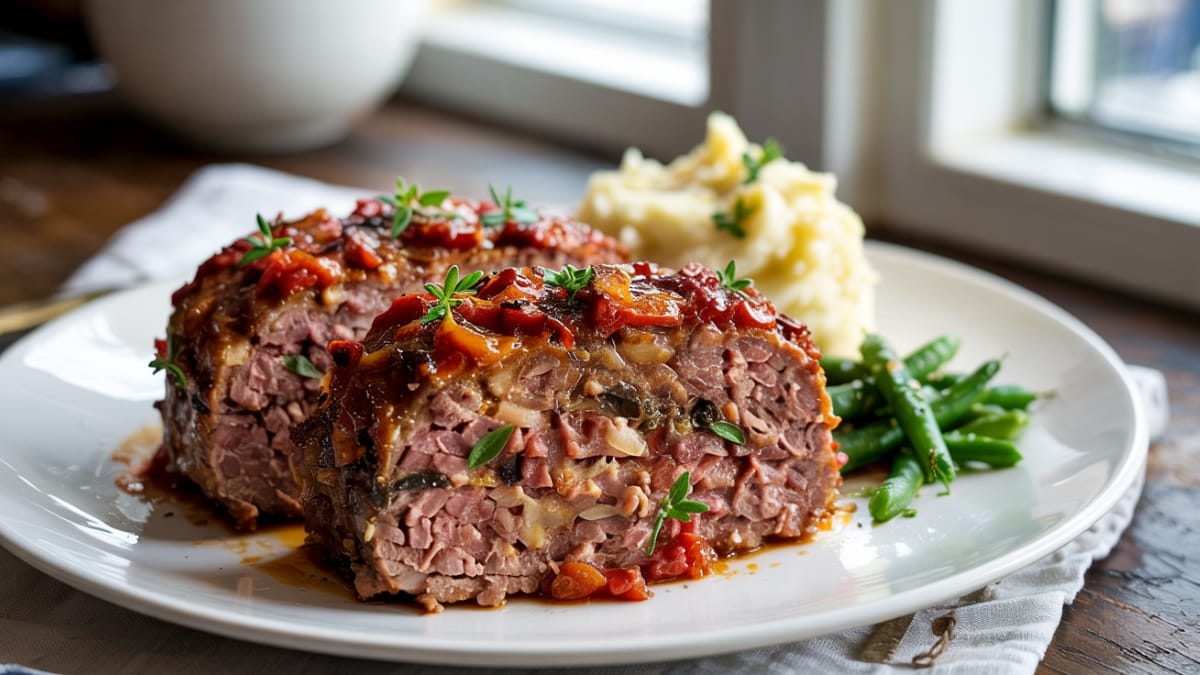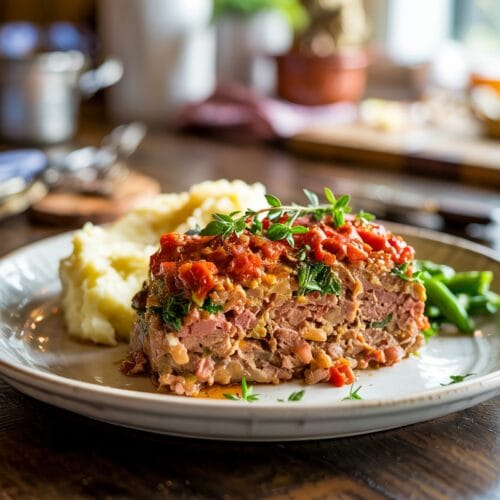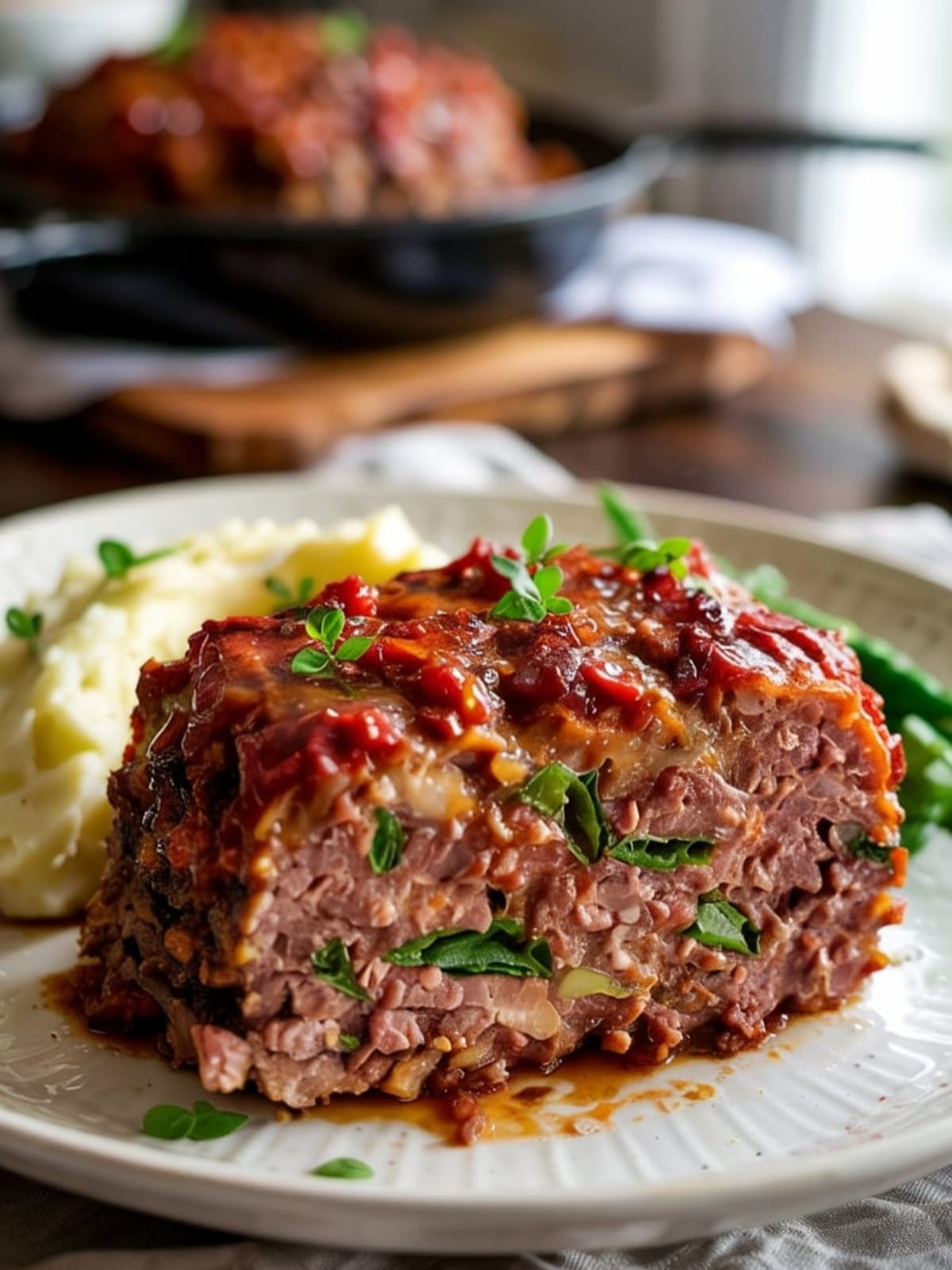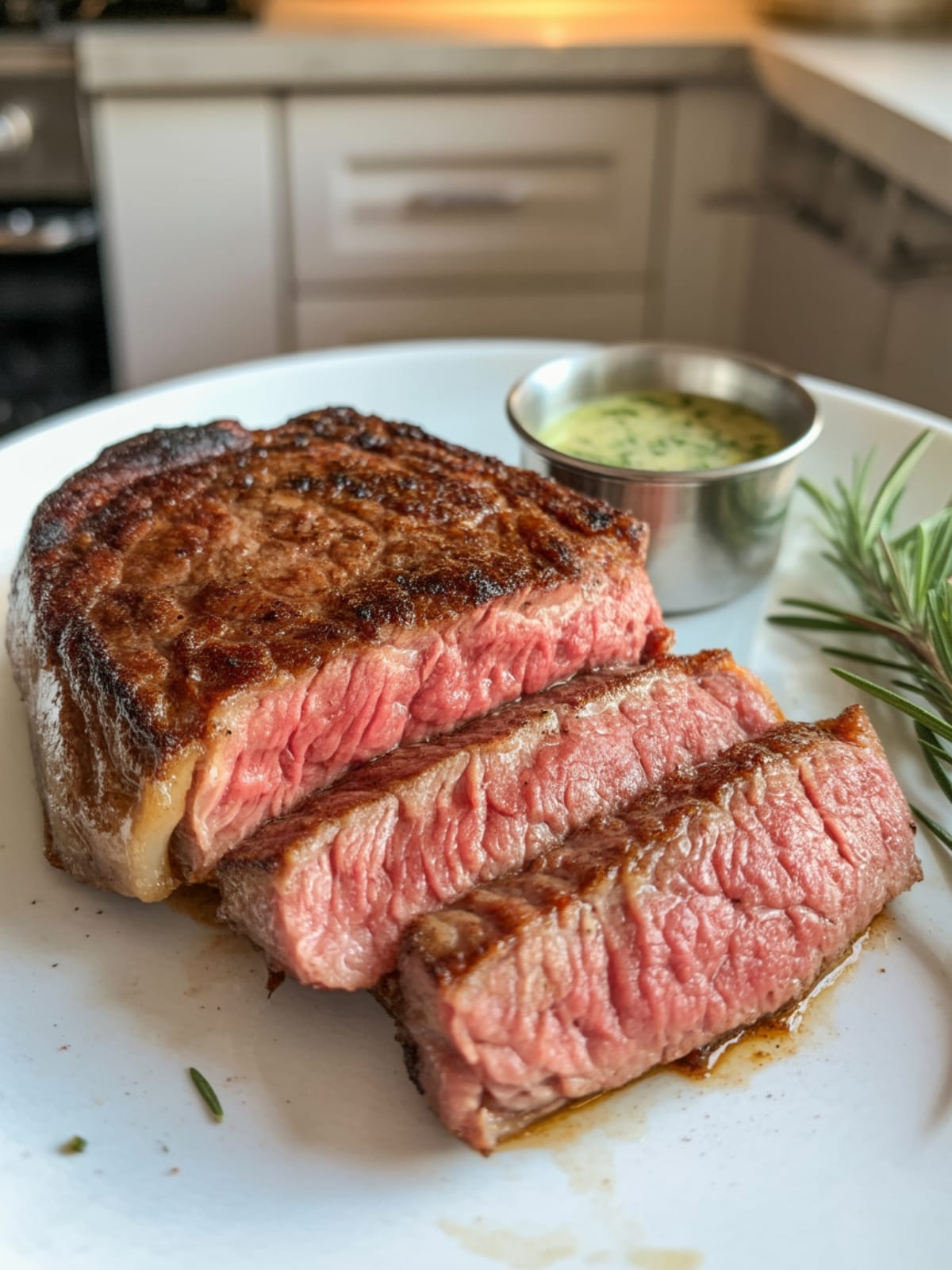Ever wondered why some meatloaves are juicy slices of heaven while others are sad, dry bricks that make you question your life choices? The secret lies in a few simple techniques that transform ordinary ground beef into the ultimate comfort food. This Moist and Savory Beef Meatloaf recipe delivers exactly what the name promises—a tender, flavorful masterpiece that’s easy enough for weeknight dinners but special enough for Sunday supper. No more dried-out disappointment, just pure meaty bliss.
Why This Recipe is Awesome

This isn’t just any meatloaf recipe—it’s the one you’ll want to pass down through generations. It strikes that perfect balance between classic and elevated, familiar and interesting.
The moisture factor is next-level. Through a combination of ingredients and techniques, this meatloaf stays incredibly juicy without being soggy. It slices beautifully without crumbling, yet melts in your mouth with each bite.
What I love most about this recipe is its versatility. Need to feed a crowd? Double it. Only have 1 pound of beef? Halve it. Want to sneak in some vegetables for picky eaters? Go right ahead. It’s essentially a culinary chameleon that adapts to your needs while maintaining its delicious integrity.
Plus, the leftovers might actually be better than the original meal. Cold meatloaf sandwich the next day? Heaven on bread. Crumbled into pasta sauce? Genius. It’s basically the gift that keeps on giving, making your initial effort pay dividends throughout the week.

Moist and Savory Beef Meatloaf
Ingredients
For the Meatloaf
- 2 pounds ground beef ideally 85/15 lean-to-fat ratio
- 1/2 pound ground pork optional, can use all beef instead
- 2 large eggs lightly beaten
- 1 medium onion finely diced (about 1 cup)
- 2 cloves garlic minced
- 1/2 cup quick oats or breadcrumbs
- 1/3 cup milk
- 1/4 cup ketchup
- 2 tablespoons Worcestershire sauce
- 1 tablespoon Dijon mustard
- 1 tablespoon fresh parsley chopped (or 1 teaspoon dried)
- 1 teaspoon dried thyme
- 1 teaspoon salt
- 1/2 teaspoon black pepper
- 1/4 teaspoon ground nutmeg trust me on this
For the Topping
- 1/2 cup ketchup
- 2 tablespoons brown sugar
- 1 tablespoon apple cider vinegar
- 1 teaspoon Worcestershire sauce
Instructions
- Preheat your oven to 350°F (175°C). Line a baking sheet with foil (if using) or lightly grease a 9×5 inch loaf pan.
- Sauté the aromatics. This step is optional but recommended: In a small skillet over medium heat, sauté the onions in a bit of oil until translucent, about 5 minutes. Add the garlic and cook for 30 seconds more. Allow to cool slightly. (This removes the raw onion bite and adds more flavor.)
- Soak the oats. In a small bowl, combine the oats and milk. Let sit for 5 minutes to soften. This is your secret weapon for moisture.
- Combine all ingredients. In a large bowl, gently mix the ground beef, ground pork (if using), beaten eggs, sautéed onions and garlic, soaked oats with milk, ketchup, Worcestershire sauce, Dijon mustard, parsley, thyme, salt, pepper, and nutmeg. Mix with your hands just until combined—don't overwork it.
- Perform the test. Take a small portion of the mixture and microwave it for 20-30 seconds or cook it in a small skillet. Taste for seasoning and adjust salt and pepper if needed.
- Shape your loaf. Transfer the meat mixture to your prepared loaf pan and shape into a loaf. If using a baking sheet, form the mixture into a loaf shape about 9×5 inches.
- Make the topping. In a small bowl, mix together the ketchup, brown sugar, apple cider vinegar, and Worcestershire sauce until the sugar dissolves.
- First bake. Bake the meatloaf uncovered for 40 minutes.
- Add the topping. After 40 minutes, remove the meatloaf from the oven and carefully drain off any excess fat. Spread the topping mixture evenly over the meatloaf.
- Finish baking. Return to the oven and bake for an additional 30-35 minutes, or until an instant-read thermometer inserted into the center registers 160°F (71°C).
- Rest before slicing. Allow the meatloaf to rest for 10-15 minutes before slicing. This helps it hold together better and keeps the juices from running out.
Notes
- The ideal meat ratio: If you’re using the beef/pork combination, aim for a 4:1 ratio. The pork adds fat and flavor, making the meatloaf exceptionally moist.
- For even juicier results, add 1/4 cup grated zucchini or carrot—they’ll virtually disappear in the final product but add significant moisture.
- Free-form option: For more caramelized exterior, form your meatloaf on a baking sheet instead of in a loaf pan. The pan method keeps it more moist, while the free-form method gives more crust.
- Temperature matters: Don’t rely on cooking time alone. Use a meat thermometer to ensure your meatloaf reaches 160°F internally.
- For mini meatloaves that cook faster, divide the mixture into a muffin tin and reduce cooking time to about 25-30 minutes total.
- Make-ahead tip: Prepare the meatloaf mixture up to 24 hours in advance, shape it, cover, and refrigerate. Let it come to room temperature for about 20 minutes before baking.
- Freezer-friendly: You can freeze the raw meatloaf (without topping) for up to 3 months. Thaw completely in the refrigerator before baking.
Calories & Nutritional Info
- Calories: Approximately 350 per serving
- Protein: 28g
- Fat: 22g
- Carbs: 12g
- Fiber: 1g
- Sodium: 750mg (varies based on ketchup used)
- Iron: 20% of daily value
- Zinc: 35% of daily value
- Vitamin B12: 45% of daily value
- Selenium: 40% of daily value
Common Mistakes to Avoid
- Using meat that’s too lean. The fat is essential for moisture and flavor. 85/15 ground beef is ideal; leaner cuts will result in a drier meatloaf.
- Overmixing the meat mixture. This creates a dense, tough texture. Mix just until ingredients are combined.
- Skipping the rest period. Cutting into meatloaf immediately after baking causes all those delicious juices to run out onto your cutting board instead of staying in the meat.
- Not testing for seasoning. That little microwave test ensures your meatloaf is properly seasoned before you commit to baking the whole thing.
- Eyeballing doneness. Use a meat thermometer to ensure food safety without overcooking.
- Packing the meat too tightly. Whether in a loaf pan or free-form, press the meat mixture together gently rather than compacting it firmly.
- Adding raw onions without sautéing. Raw onions release moisture during cooking and can make your meatloaf soggy while also retaining an unpleasant crunch.
Alternatives & Substitutions
- Meat options: Use all beef if you prefer, or try a blend with 1/4 pound ground veal for a more tender result. Ground turkey can substitute for a lighter version (add 2 tablespoons olive oil to maintain moisture).
- Breadcrumb alternatives: Crushed crackers, regular oats, or cooked rice can substitute for quick oats. For gluten-free, use certified gluten-free oats or crushed gluten-free crackers.
- Milk substitutes: Any kind of milk works, including non-dairy options. For extra richness, use half-and-half or even sour cream.
- Flavor boosters: Add 1/2 cup grated Parmesan cheese, 1/4 cup crumbled cooked bacon, or 1 tablespoon fresh grated horseradish to the mixture.
- Veggie additions: Mix in 1/2 cup finely chopped bell peppers, 1/4 cup finely chopped mushrooms, or 1/3 cup frozen (thawed and drained) spinach.
- German variation: Add 1 teaspoon caraway seeds and 1/4 teaspoon ground allspice to the meat mixture.
- Topping alternatives: Use barbecue sauce instead of ketchup for a smokier flavor, or try a mixture of equal parts Dijon mustard and maple syrup for a sweet-tangy glaze.
- Make it Italian: Add 1 teaspoon Italian seasoning, substitute 1/4 cup grated Parmesan for some of the oats, and top with marinara sauce instead of ketchup.
FAQs
Why does my meatloaf always fall apart when I slice it?
Three common culprits: 1) Not enough binding ingredients (eggs and oats/breadcrumbs), 2) Not letting it rest after baking, or 3) Not reaching the proper internal temperature. Make sure to let it rest at least 10 minutes before slicing, and verify it reaches 160°F internally.
Can I make this with just 1 pound of beef?
Absolutely! Halve all the ingredients and use a smaller loaf pan or form a smaller free-form loaf. Reduce the cooking time to about 40-45 minutes total, but still verify doneness with a thermometer.
How can I tell when my meatloaf is done without a thermometer?
While a thermometer is best, you can make a small cut in the center—the meat should be completely cooked through with no pink remaining, and the juices should run clear. However, this method risks overcooking.
Why do you recommend adding oats instead of just breadcrumbs?
Oats absorb and retain moisture better than breadcrumbs, especially when pre-soaked in milk. This creates a more tender meatloaf that stays juicy even when reheated.
What side dishes pair best with meatloaf?
Classic pairings include mashed potatoes, mac and cheese, and green beans. For a more modern spin, try roasted garlic cauliflower mash, glazed carrots, or a crisp arugula salad with lemon vinaigrette.
Can I make this recipe in advance for a dinner party?
Definitely! You can fully prepare the meatloaf (without baking) up to a day ahead and refrigerate it. Let it sit at room temperature for about 20 minutes before baking. Alternatively, you can bake it earlier in the day and reheat it covered in a 300°F oven for about 20-30 minutes.
What’s the best way to use leftover meatloaf?
Beyond the classic meatloaf sandwich, try crumbling it into pasta sauce, using it as a stuffing for bell peppers, adding it to a hash with potatoes and eggs for breakfast, or creating a shepherd’s pie-style dish with mashed potatoes on top.
Final Thoughts
This Moist and Savory Beef Meatloaf isn’t just a recipe—it’s proof that sometimes the classics really are the best, especially when prepared with care and a few key techniques. It’s the kind of dish that reminds you why certain foods have remained popular for generations: because when done right, they’re absolutely delicious.
What makes this meatloaf special isn’t fancy ingredients or complicated methods; it’s attention to the details that matter. The pre-soaked oats, the sautéed aromatics, the perfect meat ratio, and that crucial resting time all contribute to a result that’s greater than the sum of its parts.
So the next time you’re craving honest, satisfying comfort food that won’t let you down, reach for this recipe. Whether you’re feeding a family on a Tuesday night or hosting a casual weekend gathering, this meatloaf delivers the kind of uncomplicated deliciousness that makes everyone at the table feel at home.






